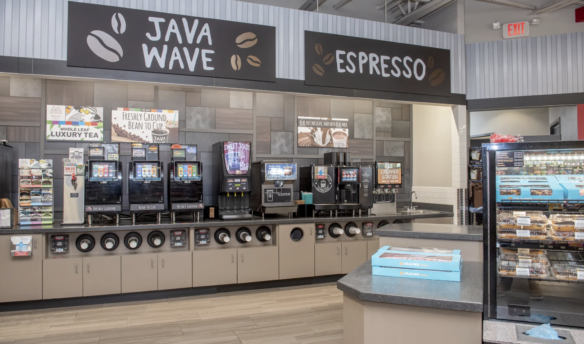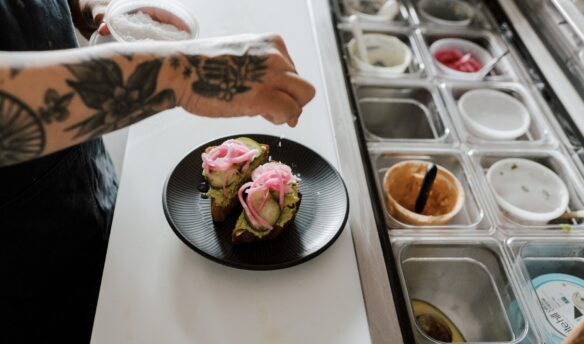[I]t’s ten am on a Friday at Birch Coffee’s 27th Street shop in Manhattan, and there’s little chance any grad students or self-employed analysts could get much work done here. The door opens and closes every few seconds, letting in the traffic noise of cars dashing off Madison Avenue. The coffee line, which begins one step into the shop, horseshoes around a narrow communal table, and because this is a New York café, the space between those in line and those at the table is intimate. The customers chatter away on phones and with each other; the baristas bang portafilters empty and clatter cups into saucers; the cook calls out “order up” on early lunch sandwiches.
This controlled whirl is what Birch owners Jeremy Lyman and Paul Schlader wanted for the atmosphere of their cafés. That a blogger hunched over a laptop would need headphones blaring at neuron-interrupting levels to push out the café buzz, well, that doesn’t fuss them a bit.
“Everyone has data on their phones now. If they really need a connection they can just turn their phone into a hotspot.”
“I don’t think coffee shops have the same level of interactions as they used to,” Lyman says. “They’re not as social as they used to be.” The culprit, he says, is Wi-Fi, or more precisely the hang out, sprawl out, and tune out behavior that a fast Internet connection enables.
The problems of Wi-Fi aren’t new to cafés, but solutions are just beginning to surface. Birch Coffee incorporates several of them. At the 27th Street shop, customers are welcome to work on laptops all day but they’ll only get Wi-Fi after five pm during the week. And they’ll get a code providing Wi-Fi for only half an hour with a purchase. “The tendency is to offer it when we are not crazy jammed so people aren’t sitting at the computers when we have people looking for tables,” Lyman says. When asked if there’s been a backlash, he grabs his phone and says, “Everyone has data on their phones now. If they really need a connection they can just turn their phone into a hotspot.”
Then he shrugs—it’s just not a worry. Behind him, two women walk in, chatting away, an Internet connection probably the last thing on their minds.
[L]ast summer saw a splattering of news stories declaring the end of free Wi-Fi in cafés. Laid out in a timeline, it looked like an epidemic moving east from San Francisco to Denver then breaking out in Chicago and New York. “Coffee Shops Take Arms Against Internet Freeloaders,” said one demure headline, though there was no evidence of café owners forcing sales at gunpoint. Other articles focused on the seeming newness of the phenomenon. A more accurate headline might have been, “Wi-Fi: Still a Pain for Some Cafés.” The recent string of stories followed a round of identical bulletins in 2010.

None of the stories featured more than three shops in each of these major metropolises, though it only takes two data points to make a newspaper trend piece, and maybe fewer for a blog post. But if the stories didn’t show a seismic shift in coffeehouse culture, they revealed how many solutions there are to the Wi-Fi conundrum. Every shop, every owner, every set of customers creates their own culture and Wi-Fi’s role (or lack thereof) fits that culture differently. A café whose goal is to provide great to-go coffee and a few seats for harried professionals to gear up for the workday has a different relationship to Wi-Fi than a café whose goal is to be a neighborhood hub and hangout.
(The terminology for those who set up and use Wi-Fi for hours and hours hasn’t settled itself, though campers, squatters, and Wi-Fi hobos are popular pejoratives. Glen Baker, who owns a bistro in Denver, calls the process of opening a computer, donning headphones, and settling in “cocooning.” Calling someone a cocooned customer seems a perfect choice: descriptive but not disparaging.)
The cafés that feel the most pressure to solve the problem of customers turning communal tables into cluttered workspaces are those with a lunch service, especially those nearby office buildings. A coffeehouse-is-my-office customer, even a conscientious one who buys something every hour or so, likely won’t produce as big a tab as a neighborhood office worker with half an hour to eat a sandwich and drink a latte. Never mind that the office worker will vacate her table for someone else on a half-hour lunch.
Wi-Fi has become so integral to the coffeehouse experience that many owners feel the only thing dumber than switching it off would be unplugging the espresso machine.
The simplest and an increasingly popular solution to this type of problem is to just switch off the router during lunch. That can be a scary thing for a café. Wi-Fi has become so integral to the coffeehouse experience that many owners feel the only thing dumber than switching it off would be unplugging the espresso machine. But like the guys at Birch, owner after owner has described the frustration of lunch customers finding no table open. It may be nice to have a full shop, but a packed and rotating shop for two hours can be much more profitable.
Other strategies seek to have both a robust lunch crowd and a comfortable third space. From noon to two am at Coffee Shop in San Francisco, owner Luigi Di Ruocco sets aside twenty of his sixty-five seats as computer-free and limits customers to half an hour in the chair. Many cafés reverse that setup and entice laptop users to Internet-friendly seats, sometimes resembling mini cubicles, with plug-ins and space to lay out work. Often these are on the periphery of the shop, leaving the middle of the café to retain the social feel so important to many owners.
It’s an old approach, but making electrical outlets inaccessible by covering them requires a few minutes of effort and no supervision or special software. And there’s more than one reason to do it. In Denver, Crema Coffee House covered the sole electrical outlet in the seating area simply because the power cables plugged into it were ugly.
Alternatively, for many shops there is just no problem with Wi-Fi. Penelope Winett, the owner of Holy Cow Coffee and Tea in Sebastopol, California, can’t imagine her downtown café without Internet. Really, she can’t image coffee shops without it. “I don’t think you can take Internet out of a café,” she says. “I don’t know why I would want to.” If she cut the Internet, she says it would just cut into her business.
[F]or every news story about the end of free café Wi-Fi, there are ten that equate coffeehouse Internet connections to a bad corner in a seedy neighborhood. A USA Today story began, “Waiting like a mugger in a dark corner may be a hacker, intercepting such information as your credit card numbers, name, address and more before it ever reaches the Internet shoe seller.” When coffeehouse Internet isn’t treated as a birthright, it’s a scary, scary sign of the Internet’s questionable security.
Coffeehouse owners needn’t worry much. When you provide customers free Internet, you’re considered, by the law, an Internet service provider. For the same reason a server can’t be prosecuted or sued for something done on it by a customer, a café owner isn’t responsible if someone’s ill-timed Amazon purchase ends in identity theft.
The biggest legal threat to coffeehouses offering free Wi-Fi over the past few years was the patent troll Innovatio. Back in 2011, this company began issuing letters to hotels and coffee shops demanding they pay up for infringing on their patents that, they claimed, invented the concept of Wi-Fi. They wanted up to $2,500 for a café to have the privilege of using their invention—a solid amount of money but far less than a lawyer’s bill to fight back. Cisco and other router makers came riding in wearing white hats, countersuing Innovatio for racketeering. Though that charge was tossed by a judge, in February Cisco and the others succeeded in buying off Innovatio for far less than it would have gotten from the thousands of small business they targeted.

Buying slower Internet to discourage streaming could become a solution for many cafés. More difficult, instead of providing customers Internet for a fixed amount of time per purchase, a new strategy may be to allot a fixed amount of data per purchase. That would require an investment in software and more management time to maintain the system.
With so many variables and potential problems, Davis Street Espresso in Dallas might provide a new (read: old) model. The brand new café follows the blueprint of hardcore coffee shops: a limited drink menu, no syrups, no to-go cups, only whole milk. They extend that austere, we-focus-just-on-coffee aesthetic to their Wi-Fi policy. They just don’t have it.
—Cory Eldridge is Fresh Cup’s editor.















